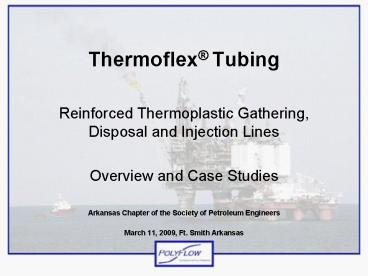Thermoflex Tubing PowerPoint PPT Presentation
1 / 34
Title: Thermoflex Tubing
1
Thermoflex Tubing
- Reinforced Thermoplastic Gathering, Disposal and
Injection Lines - Overview and Case Studies
- Arkansas Chapter of the Society of Petroleum
Engineers - March 11, 2009, Ft. Smith Arkansas
2
Why Use Thermoflex Tubing
- Corrosion Resistance/ Hydrocarbon Resistance
- Rapid Installation vs. Steel
- Lighter Duty Equipment
- Less Footprint on Surface
- Paraffin or Scale Issues
- Reduced Pressure Drop vs. Steel
3
Advantages of New Polymers
- Polyethylene has been Available for Years.
- Good to 60C Operating Temperatures
- Paraffin Adheres to Polyethylene
- Poor Permeation Properties
- New Polymers with High Strength, Improved
Corrosion Resistance, and Higher Temperature
Performance Now Available - Multi-Layer Technology has Reduced the Costs of
Liners for Severe Applications
4
New Engineered Plastics Provide Higher
Temperature Strength Not Available From
Polyethylene (PE)
Fortron
Capron
PE
5
Liner Construction Design
- Multi-layer Design
- Inner Layer for Corrosion Resistance, Low
Permeation and Higher Temp Strength . . . Nylon
and Fortron - Outer Layer for Higher Temperature Strength,
Abrasion Resistance . . . Capron or PP - Fully Bonded
- Applications to 250F
Inner Barrier
Outer Strength and Abrasion Layer
6
Reinforced Tubing Design and Construction
- Multi-layer Design
- Inner and Outer Barrier Layers
- Center Layer Provides Higher Temperature Strength
- Fiber reinforced with Kevlar for Strength,
Tensile Load, and Burst - Tubing Strength P(2Fn)/DL
7
Couplings and Terminations
- Required for Each End of the Tubing
- Threaded, Weld, Flange Styles Available
- Carbon or Duplex Stainless Steel
- Joint less Unions
8
Coupling Requirements
- Portable Coupling Machines
- Up to 4.5
- For Termination and Union Couplings
- 10,000PSI Hydraulic Pump
9
Design Strength vs. Short Term Burst Strength
10
Testing Standards
- API 15S Developed a Composite Pipe/Tubing
Specification - ASTM D1598 Best Standard for Reinforced
Thermoplastics Tubing - ASTM D2292 Best Standard for Reinforced
Thermosetting Tubing (Fiberglass) - Couplings are ANSI 600 Rated
11
Paraffin Testing
No Evidence of Paraffin Adhesion On the Piping
There is Adhesion to Unlined Metal Fittings
12
Delivery of Tubing
- Comes in Spools
- Length Dependent Upon OD and Pressure Rating
- Spools can be Broken Down after Use
13
Downhole Applications
- Velocity Strings
- Submersible ESP Tubing
- Injection Strings
- Well Jetting Strings
14
Pressure Drop 1 3/4 Thermoflex
Steel
Thermoflex
15
Channeling the Gas
- Small Diameter Tubes . . . No U-Tubing
- Set Above Lowest Gas
- Packer or Cone
16
Conventional Installation
- 1.75 Velocity String for 2,591M Well
- Weight 1,560Kg
- Thermoflex inside of 2 3/8 Steel
- Conventional Coil Tubing Unit
17
Reed A1 Performance
18
Low Cost Multi-Zone Case
- Five Perforation Zones over 304M
- Weekly Soaping and Blowing/ Monthly Swabbing
- Where to Set the Tubing?
19
Results of Multi-zone Case
20
Utilizing Submersible Pumps off of Thermoflex
Tubing
- Increases Fluid Velocity to Lift Solids
- Rapid/Low Cost Installation and Removal
- Suitable for CBM
- Resists CO2
21
Injection Applications
- Gas Injection
- Chemical/ Fluid Injection
- Banded to Tubing or Free Hanging
- Submersible Production Applications
22
Well Jetting
- 1.75 String to Jet 4.5 Casing
- 200PSI Injection Pressure
- Insertion Rate of 20ft/min
- Depths to 7,000ft
- 3 Per Day
23
Surface Applications
- Gathering Lines
- Disposal Lines
- Injection Lines
- Water
- CO2/Water
- Rehabilitation of Steel Lines
24
Methods of Installation
- Direct Bury
- Continuous Plowing
- Trenching
- Pulled Through Existing Steel Pipe
- Sizing Dependent Upon Restrictions in Steel
- Pig with wire line and pull pipe
25
Direct Bury
- Plow, Continuous or Backhoe Trenching
- Pre-trenched ditches 2 Km per Hour
- Pull Pipe off Stationary Spools
- Savings 5-6/ft Installed vs. Steel
26
Brine Disposal Line
- 4.5 Thermoflex, 500PSI 750PSI
- 10ft. Spools for Shipping
- Unwind or Drag Off
- 50,000ft in Three Weeks
27
Installation Through Hills
- Pull from Top to Bottom if Possible
- No Special Backfilling Requirements
- Tamping or Compaction a Function of Soil
Conditions
28
Inserting In Steel Pipe
- Pig Cable Through
- Pull Pipe Back Through
- Tensile Load Based Upon Drag
- Capable of Multiple Kilometer Pulls
29
Pull Through Steel Pipe
- Pull with Coupling or with Bolts
- Pull Strength Varies by Longitudinal Braids
- Polyflow Models Pulls
30
Pulling Thermoflex Through
- 2 3/8 in 3 ID Steel
- Do not Recommend Pulling through Elbows
- Pull Speed 100ft/min
31
Offshore Rehabilitation
- Pull 3.5 Through 8 Flexible Steel Line for
6,000ft - Single Pull Platform to Platform
- 90 Cost Savings vs.Replacment
32
Double Walled System
- Pull Thermoflex Through Carbon Steel
- Flanged Terminations
- Fill Annulus with Packer Fluid/ Inert Fluid
- Monitor Pressure on the Annulus
33
Modeling Gathering Lines
- Single or Multi-phase flow
- Comparison to Steel
- Smaller Diameter for Equal Pressure Drop
- Less Effects Due to Continuous Runs
2 3/8 Steel
Thermoflex
34
So Why Use Thermoflex?
- Low Cost Rapid Installation
- Corrosion Resistance
- Reduced Pressure drop vs. Steel
- Low Cost Rehabilitation of Existing Lines

